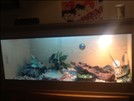You're in > TPG Members Forum > Indoor and Outdoor Enclosures > Do i have the right indoor enlosure? |
|
| Do i have the right indoor enlosure? Posted: 11/02/2013 by Wemma |
|
Hi all, | |

| |
| Re: Do i have the right indoor enlosure? Posted: 11/02/2013 by TPGDarren |
|
Hi Emma, Thank You for taking the time to contact us, it’s lovely to hear from you. Sorry I'm not a great fan of any reptile shops:-(. Firstly they put all their reptiles in a vivarium, no matter what climate they originate from. Be it a high humidity South American rainforest, or a low humidity desert. No matter how much Retile shops protest, animals should not be sold in this short-sighted manner. They do however have to be kept in a vivariums to stop them running off and escaping their prisons. In order to provide a good environment you have to first study what climate they come from. They have evolved in this climate over millions of years and so a one for all vivarium is totally ignorant. Tortoises are infact one of the few reptiles that we can provide a decent environment for – because we can let them roam the garden when the weather is warm enough and they won’t be running off over a fence or up a tree. You're quite right to raise the question as Hermanns tortoises shouldn't be kept in a vivarium at all. Despite what most pet shops and other dealers promote, most species of tortoises to not fair well in vivariums (including Hermanns, Spur-Thighed Tortoises & Horsfelds). It is NOT true that cold-blooded animals need to be kept constantly warm. Unlike us and other mammals, who maintain our body temperature physiologically, reptiles must be permitted to manage their body temperatures themselves to meet their needs at a given time by seeking warmer or cooler areas of the environment. Many tortoises need a range of temperatures to be able to maintain their immunity, metabolism and activity. Failure to meet the range in temperatures will at the very least result in a tortoise living a miserable existence and possibly their demise. These vivarium set-ups often contain inferior lamps, incorrect substrates, unnecessary heat mats, tortoise pellets – to list just a few things wrong with them. Here are a couple of links that may help:- Care sheets:- http://www.tortoise-protection-group.org.uk/site/88.asp
Ideas for set-ups:- Either a small rabbit/guinea pig enclosure (best to get the larger one 1.2 meters) or a commercial (or home-made) tortoise table can be used. Tortoise Tables can easily be constructed with 4 lengths of wood and a base for very little money, probably as little as £10-£15 http://www.tortoise-protection-group.org.uk/site/58.asp Sorry for such a lengthy reply, but I would definitely look at getting a tortoise table and look at the equipment they have supplied to see what can be salvaged. Please do get back to us if you’re not sure, we are always happy to helpJ HTH Darren | |





